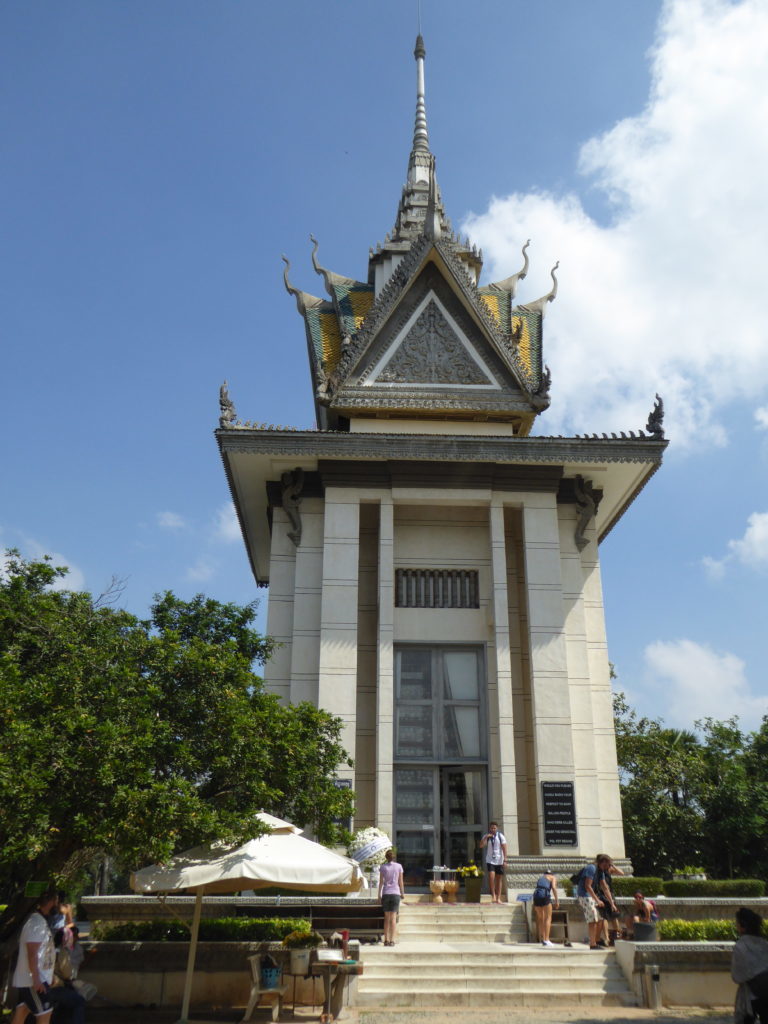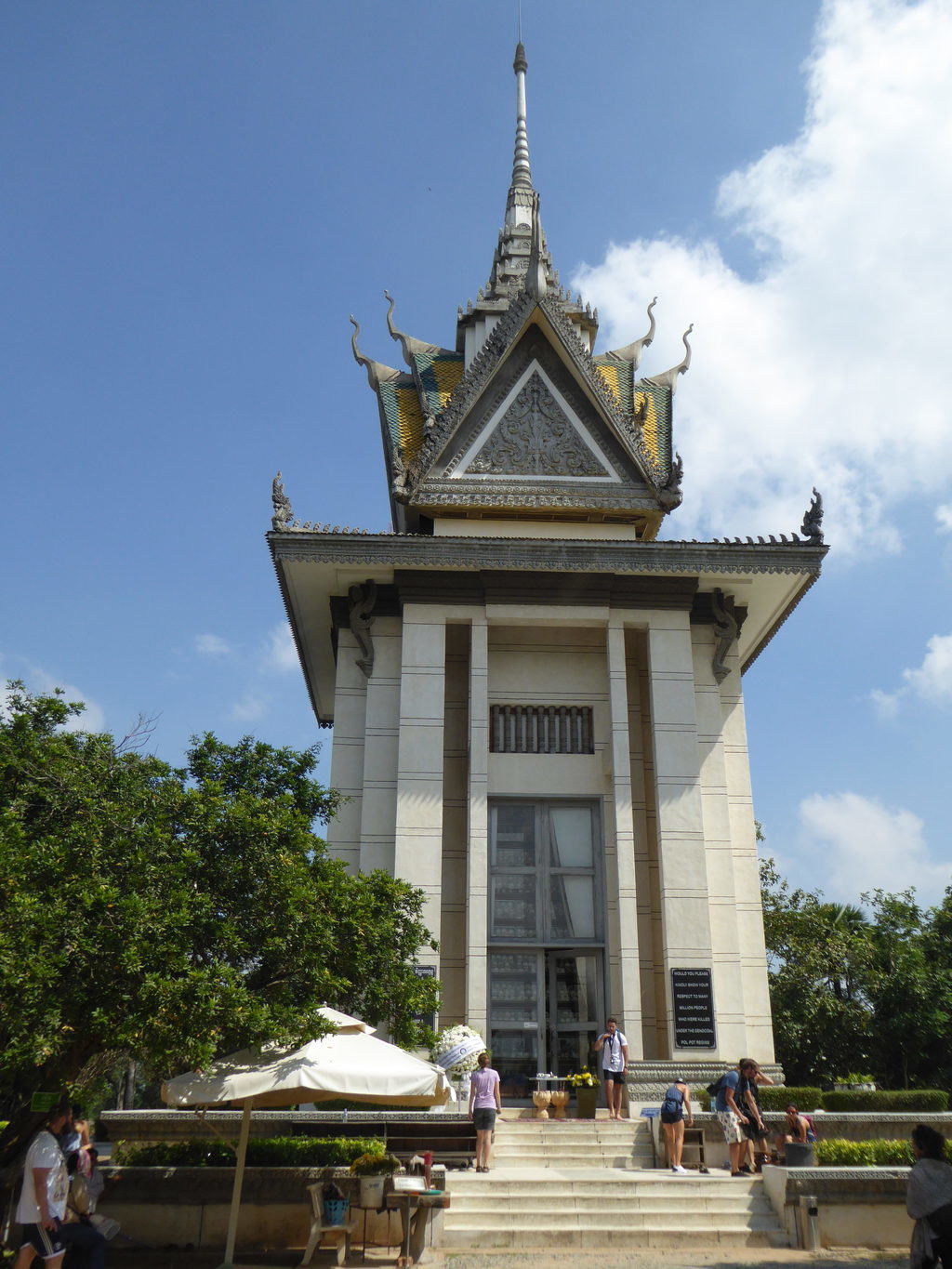Unfortunately this post will not be a very uplifting one. However, I think it is important that the darker side of humanity also be discussed. Traveling is not always about personal enjoyment, but also about gaining a better understanding of our world.
While in Phnom Penh, Cambodia we learned about one of the greatest atrocities of the 20th century; the genocide of 2-3 million Cambodians between 1975-1979 under Pol Pot’s Khmer Rouge regime. We visited the killing field of Choeng Ek where over 20,000 people were tortured, executed, and buried in mass graves. Choeng Ek is only one of over 300 such killing fields scattered throughout Cambodia that lay testimony to the sheer inhumanity of the Khmer Rouge.
The Choeng Ek Killing Field is now a museum which gives visitors a window into what happened during those 5 terrible years. There you can see dozens of mass graves as well as thousands of skulls and bones of those executed. We heard horrible stories from some of the survivors of the Khmer Rouge regime, detailing their treatment at the hands of their captors. There were even a few stories from some of the Khmer Rouge officials who spoke of their remorse and culpability at their war crimes hearings in 1998.
The reason for all of this killing is because Pol Pot wanted to return Cambodia to a “Pure Society”, agrarian based and entirely self sufficient. He outlawed currency and land ownership, closed factories, schools and hospitals. He even turned the calendar back to year zero. He then began to purge the country of anyone he deemed unfit for this new society. Pol Pot targeted anyone who wasn’t one of the “old people”, a term he gave to the farmers and peasants of Cambodia. If you were one of the “new people” and lived in a city, were a teacher, a lawyer, a doctor, a monk, wore eyeglasses, had soft hands, or spoke a foreign language, you were a target of the Khmer Rouge. These “new people” were emptied from the cities and forcefully relocated to rural areas of Cambodia. Hundreds of thousands were beaten, raped, tortured, and ultimately executed. Hundreds of thousands more died because of starvation. All due to the fanatical vision of one hateful human being. This end was not met by just adult men either, women and children were also subject to these atrocities. As Pol Pot himself said, “In order to dig up the grass, one must also dig up the roots”. This was his justification for killing children. Another chilling quote of Pol Pot’s that we heard while at Choeung Ek: “To keep you is no gain, to lose you is no loss”
While we were glad that we decided to visit the memorial at Cheoung Ek, it was a very difficult place to see. It was impossible to walk through the place with dry eyes, knowing that so many thousands of people were executed there.
I only took one picture while at Choeung Ek, one of the memorial built to remember those killed. It now holds the skulls and bones of over 10,000 of those killed at the site.

After visiting Choeung Ek, we went to the Tuol Sleng Museum. Known as S-21 under the Khmer Rouge, Tuol Sleng was used as a prison for anyone the Khmer Rouge saw as a threat to their newly established regime. Prisoners at S-21 were subject to brutal conditions and torture before they were ultimately sent to killing fields. The Khmer Rouge would often force prisoners to confess to crimes they never committed, in order to justify their execution. One story we heard was of a 27 year old New Zealander who was imprisoned at Tuol Sleng. He was in the middle of a round-the-world sailing trip when he sailed into Cambodian waters and was picked up by the Khmer Rouge. He was tortured and forced to confess that he was a CIA spy. Maintaining his humor under these horrific conditions, he told the Khmer Rouge that he was in fact a CIA spy and that his commanding officer was Colonel Sanders of the KFC brigade. He was later executed. Of the over 20,000 people that were sent to Tuol Sleng, there are only 12 known survivors.

We not only learned about the horrible atrocities of the Khmer Rouge regime, but we also learned about some of the terrible policies of the U.S. and other western nations at the time. The year when the Khmer Rouge came to power, 1975, was the same year that Saigon fell and communist North Vietnam claimed victory against the U.S. and South Vietnam. The Khmer Rouge was hostile to Vietnam and began carrying out border raids into Vietnam. The U.S. was also hostile to Vietnam because it was in the midst of the fear-mongering anti-communist era initiated by Senator Joseph McCarthy. In a bid to curb Vietnamese influence, the U.S. provided money and weapons to Pol Pot and the Khmer Rouge regime. The support continued to flow to the Khmer Rouge years after the genocide had taken place. All because the U.S. was afraid of the so-called “domino effect” that was thought would occur once one nation fell under communist sway. So, in order to counter the communist influence of Vietnam after the Vietnam War, the U.S. supported the genocidal (and communist) regime of the Khmer Rouge.
However, it wasn’t just the policy of the U.S. to support the Khmer Rouge. Up until 1993, the only recognized Cambodian ambassador to the United Nations was from the Khmer Rouge. Yes, it took the western world a full 15 years to finally formally recognize that the Khmer Rouge was not the legitimate ruling party of Cambodia. 15 years after the genocide of 2-3 million Cambodians at the hands of the Khmer Rouge.
Learning about this part of history reminded me of something I feel is very important:
We should all stay informed about the world around us and of our government’s role within that world. When the basic human rights of anyone in this world are being violated, stand up and oppose it. Even if it means standing up to your own government.


Comments
1 CommentKaren
Jan 16, 2017Hear hear!! Love your last paragraph! We’re complicit if we don’t stand up and stay informed to hold those with power accountable. And acknowledge America’s ugly role in far too many places! Thanks for sharing about the killing fields – that documentary with interviews with Brother Number Two is called “Enemies of the People”. Really good. Also related is a fantastic documentary about the Indonesian killing fields (another mass murder hardly talked about) called “The Act of Killing”. It also interviews the perpetrators. It’s very worth watching if you go (or when you’re back).